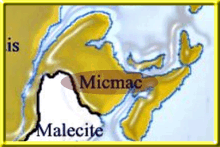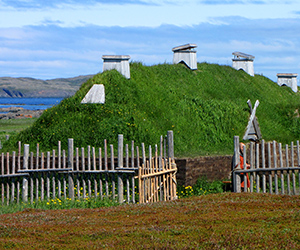CANADA HISTORY
Salish

The Salish people, also known as the Salishan people, are a diverse group of indigenous peoples who lived along the Pacific coast in what is now the United States and Canada. Prior to contact with Europeans, the Salish lived in a series of interconnected villages and relied on fishing, hunting, and gathering for their subsistence. They had a rich cultural heritage, including a complex social structure, a tradition of oral storytelling, and a deep spiritual connection to the land and the natural world.
The indigenous peoples of North America, including the Salish people, are believed to have descended from Asian ancestors who crossed a land bridge connecting Asia and North America during the last ice age. This land bridge, known as Beringia, was located in the area of the Bering Strait and was covered by a massive ice sheet during the last ice age.
As the climate warmed, the ice sheet receded and the land bridge became exposed, allowing humans and other animals to migrate from Asia to North America. This is known as the "Bering Land Bridge Theory." It is estimated that the first human migrants arrived in North America from Asia around 15,000 to 20,000 years ago.
Over time, these migrants and their descendants spread across the continent, eventually reaching what is now the Pacific Northwest region and becoming the Salish people. The Salish people, along with other indigenous peoples of North America, have a rich and diverse cultural heritage that reflects their unique experiences and history in the region.
The Salish people had a well-established trade network, which extended from the coast to the interior of the region. They traded goods such as salmon, sea otter pelts, and cedar bark for items such as obsidian, horses, and foodstuffs like potatoes and corn.
In terms of governance, the Salish people had a system of leadership that was based on a combination of hereditary and elected positions. There were also highly developed traditions of inter-tribal diplomacy, including the use of "peace medals" to symbolize agreements between different groups.
The Salish people were hunter-gatherers and relied on a variety of sources for their food and materials. They lived along the Pacific coast in what is now the United States and Canada and had access to a rich array of resources from both the land and the sea.
For food, the Salish people relied on fishing and hunting, with salmon being a particularly important source of protein. They also gathered a variety of wild plants, including roots, berries, and nuts, which provided additional food and nutrition.
In terms of materials, the Salish people utilized a variety of resources from the forests and other natural habitats in their region. For example, they used cedar trees for building homes, clothing, and boats, and relied on the forest for firewood and other resources. They also harvested a variety of materials from the sea, such as shellfish and seaweed, which were used for food, medicine, and tools.
The Salish people also had a well-established trade network, which extended from the coast to the interior of the region. They traded goods such as salmon, sea otter pelts, and cedar bark for items such as obsidian, horses, and foodstuffs like potatoes and corn. This trade allowed the Salish people to access resources and materials that were not available in their immediate area, and it played an important role in their cultural, economic, and social life.
The Salish people had a rich spiritual tradition that was deeply intertwined with their relationship to the land and the natural world. Their beliefs were animistic, meaning that they saw the spirit as present in all things, including animals, plants, and the environment.
The Salish people believed in a pantheon of spirits and deities, each with its own unique attributes and responsibilities. For example, there was a spirit responsible for the sun, another for the moon, and others for various aspects of nature such as the wind, the water, and the forests.
The Salish people also believed in the power of dreams, which they believed could bring messages and guidance from the spirit world. They had elaborate rituals for interpreting dreams and for seeking guidance from the spirits in their daily lives.
The spiritual beliefs of the Salish people were an important part of their culture and identity, and they played a central role in shaping their relationship to the world around them. The Salish people saw themselves as caretakers of the land, and their spiritual beliefs encouraged them to live in harmony with the natural world and to respect the balance of the ecosystem.
Despite the challenges posed by contact with Europeans and the pressures of modernization, the Salish people have maintained many of their spiritual beliefs and practices, and they continue to play an important role in their cultural identity and heritage.
The Salish people had a variety of relationships with other indigenous peoples in the Pacific Northwest region of what is now the United States and Canada. Some of these relationships were peaceful and cooperative, while others were marked by conflict and competition.
The Salish people were part of a larger linguistic and cultural group known as the Salishan peoples, which included a number of distinct tribes that shared similar languages, cultural practices, and spiritual beliefs. These tribes had close relationships and frequently interacted with each other through trade, intermarriage, and other social and cultural exchange.
The Salish people also had relationships with other indigenous peoples who lived in their region, including the Nuu-chah-nulth, Kwakwaka'wakw, and Tlingit, among others. These relationships varied and could range from peaceful and cooperative to hostile and competitive, depending on a variety of factors such as resource availability, territorial disputes, and historical conflicts.
Despite these tensions, the indigenous peoples of the Pacific Northwest region also had a rich tradition of trade and exchange, which allowed them to access a variety of resources and materials and to foster relationships with other communities. Through these interactions, they built a complex web of relationships that helped to shape the cultural, social, and economic landscape of the region.
Overall, the relationships between the Salish people and other indigenous peoples in the Pacific Northwest were complex and varied, and they were shaped by a wide range of historical, social, and cultural factors.
Yes, some indigenous peoples of the Pacific Northwest region, including the Salish people, practiced slavery. Indigenous peoples in the Pacific Northwest region took captives as slaves as a result of warfare or other forms of conflict, and slaves were often used as laborers or traded for goods. Slaves were considered a valuable form of wealth and could be used as a form of currency in trade.
In some cases, indigenous peoples also took captives from other tribes as a form of tribute, as a way to build political alliances, or as a means of securing peace. Some slaves were treated relatively well and were integrated into their captors' families, while others were subjected to harsh treatment and forced labor.
Slavery among indigenous peoples of the Pacific Northwest region was eventually abolished after contact with Europeans, as European norms and laws came to be adopted and imposed in the region. Today, the practice of slavery is widely regarded as a violation of human rights and is widely condemned by both indigenous and non-indigenous peoples.
The form of warfare practiced by the Salish people and other indigenous peoples of the Pacific Northwest region was shaped by a complex set of social, cultural, and economic factors. War was not a constant or continuous state of affairs, but rather was initiated for specific reasons, such as territorial disputes, resource competition, or revenge.
Indigenous peoples of the Pacific Northwest region were well-organized and well-equipped for warfare, and they had a range of weapons and tactics at their disposal. Some of the most common weapons used in indigenous warfare in the region included bows and arrows, spears, clubs, and war hats, which were large wooden helmets used for protection in battle.
Indigenous warfare in the Pacific Northwest region was typically characterized by raids and ambushes, rather than large-scale battles. Warriors from opposing sides would try to surprise each other and to inflict maximum damage with minimal risk to their own warriors. In some cases, indigenous peoples would engage in hand-to-hand combat using their weapons, while in other cases, they would use guerrilla-style tactics to evade their enemies and to launch surprise attacks.
In addition to military tactics, indigenous peoples in the Pacific Northwest region also relied on psychological and spiritual strategies in their wars. For example, warriors would often use symbols and signs to intimidate their enemies and to demonstrate their courage and strength. They would also engage in rituals and ceremonies to invoke the support of the spirits and to strengthen their resolve in battle.
Overall, the form of warfare practiced by the Salish people and other indigenous peoples of the Pacific Northwest region was shaped by a complex interplay of social, cultural, and economic factors, and was characterized by a range of weapons, tactics, and strategies.
The political structure of the Salish people and other indigenous peoples of the Pacific Northwest region was highly organized and complex, reflecting their rich cultural heritage and sophisticated social systems.
Traditionally, the Salish people were organized into loosely-affiliated villages or tribes, each of which was led by a chief or a council of elders. The chief was typically the most respected and influential person in the village and was responsible for making decisions on behalf of the community. In some cases, the chief also had religious and spiritual responsibilities, and was considered a spiritual leader as well as a political one.
The council of elders was also an important part of the political structure of the Salish people and other indigenous peoples of the region. The council was composed of respected leaders from the community and was responsible for advising the chief and for making decisions on important matters. The council was also responsible for maintaining order and resolving disputes within the community.
In addition to the village or tribal structure, the Salish people and other indigenous peoples of the region also had larger political entities that united several villages or tribes. These entities, which could be called confederacies or alliances, were formed for a variety of reasons, including to coordinate defense against common enemies, to share resources and trade, and to promote peace and cooperation.
The political structure of the Salish people and other indigenous peoples of the Pacific Northwest region was highly adaptive and flexible, and was shaped by a wide range of social, cultural, and economic factors. Despite the many changes that have occurred in the region since contact with Europeans, the legacy of this rich and sophisticated political heritage continues to be an important part of the cultural heritage of the indigenous peoples of the Pacific Northwest.
The first recorded contact between the Salish people and Europeans took place in the late 1700s, when Spanish and British explorers began to explore the Pacific Northwest region of what is now the United States and Canada.
The first recorded European to visit the area inhabited by the Salish people was Spanish explorer Juan Pérez, who sailed along the coast of British Columbia in 1774. In the following years, other Spanish, British, and American explorers visited the region and made contact with the Salish and other indigenous peoples.
However, it wasn't until the arrival of fur traders in the late 1700s and early 1800s that significant and sustained contact was established between the Salish and Europeans. Fur traders, who came to the region in search of beaver pelts, established trading posts and established relationships with the Salish and other indigenous peoples, who provided them with pelts in exchange for goods such as guns, blankets, and metal tools.
Captain George Vancouver made contact with the Salish people and other indigenous peoples of the Pacific Northwest region during his explorations of the region in the late 1700s.
Captain Vancouver was a British explorer who was sent to the Pacific Northwest region by the British government in 1791 to survey the coast and to claim the region for Britain. During his explorations, Vancouver made contact with a wide range of indigenous peoples, including the Salish, and he recorded detailed observations about their cultures, languages, and ways of life.
Vancouver's encounters with the Salish and other indigenous peoples of the Pacific Northwest region were some of the first sustained interactions between Europeans and these peoples, and they helped to establish the foundation for future relationships and interactions between the two groups. Despite the many challenges and conflicts that arose over time, the legacy of Captain Vancouver's explorations and his interactions with the Salish and other indigenous peoples continues to be an important part of the history of the Pacific Northwest region.
Here are a few key events and dates that help to illustrate some of the important events and developments in the history of the Salish people:
Pre-Contact (prior to late 1700s): For thousands of years prior to contact with Europeans, the Salish people lived in the Pacific Northwest region of what is now the United States and Canada, where they developed a rich and complex culture and way of life that was based on their relationship with the land and their spiritual beliefs.
First Contact with Europeans (late 1700s): The first recorded contact between the Salish people and Europeans took place in the late 1700s, when Spanish and British explorers began to explore the Pacific Northwest region.
Arrival of Fur Traders (late 1700s and early 1800s): The arrival of fur traders in the late 1700s and early 1800s marked the beginning of significant and sustained contact between the Salish and Europeans.
First Treaties with the United States (1855-1856): In the mid-1800s, the Salish people and other indigenous peoples of the Pacific Northwest region entered into treaties with the United States government, in which they ceded land in exchange for guaranteed fishing rights, protection, and other benefits.
Allotment Act (1887): The Allotment Act of 1887 was a federal law that resulted in the forced relocation of many indigenous peoples, including the Salish, to reservations.
Termination Policy (1953-1968): The Termination Policy of the 1950s and 1960s was a federal policy that aimed to end the special relationship between the United States government and indigenous peoples and to assimilate indigenous peoples into American society.
Re-assertion of Sovereignty (late 20th century to present): In the late 20th century, the Salish people and other indigenous peoples of the Pacific Northwest region began a process of re-asserting their sovereignty and reclaiming their cultural heritage and traditions. This movement has continued to gain momentum in recent years and has resulted in a resurgence of indigenous culture, language, and traditions in the Pacific Northwest region.

Cite Article : www.canadahistory.com/sections/documents




